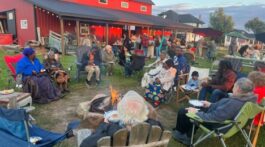Who can cheer the heart like Jesus,
By His presence all divine?
True and tender, pure and precious,
Oh, how blest to call Him mine!
All that thrills my soul is Jesus;
He is more than life to me;
And the fairest of ten thousand,
In my blessed Lord I see.
—Thoro Harris
“All That Thrills My Soul” is number 189 in the Seventh-day Adventist Church Hymnal. It was first published in 1931 by Thoro Harris, who may be one of the most prolific composers and compilers of hymns of whom you have never heard. His sister, Worthie Harris Holden, was also a noted Seventh-day Adventist poet, who regularly contributed poetry to the Advent Review and Sabbath Herald and other Adventist publications between 1891 and 1924. However, their story is more than literary biography.
The siblings were born—Worthie on March 11, 1871, in South Carolina, and Thoro on March 31, 1874, in Washington, DC—to a mixed race couple, Joseph Dennis Harris and Elizabeth Worthington Harris. In a society that required nearly everyone to identify as either black or white (not counting Native Americans and those of Hispanic or Asian descent), Worthie and Thoro would eventually “pass” into white society. Their cousin Esther Georgia Irving Cooper, identifying as black, became a civil rights activist, while an uncle, Cicero Richardson Harris, was a bishop in the African Methodist Episcopal Zion Church, but these relatives were strangers to them. Worthie’s and Thoro’s parents married in North Carolina at a time when interracial marriages were illegal, but the details of how they circumvented this law are missing. What is clearly evident and makes this story so interesting is the insight it provides into the process of “passing.” According to a 2019 study from the Bureau of Economic Research, passing was a widespread phenomenon in the United States between 1880 and 1940. In the Jim Crow era of oppressive discrimination, rigid segregation, and “one drop” policies that assigned race based on association, to successfully pass required active choice, dramatic changes, and secrecy akin to entering witness protection. It also required that one have enough European ancestry that one’s physical features could pass for white.
Paternal Heritage
Joseph Dennis Harris himself was born into a household of mixed free and enslaved “colored” people around 1833 near Fayetteville, North Carolina. Neither the 1830 census nor the 1840 census list individuals, which makes it difficult for the researcher to learn much more. However, when Joseph’s father, Jacob Harris, died in 1847, he left behind considerable property of which his wife had use for life or until she remarried. In that case, the property was to be divided among their eight children.
The origins of Joseph’s mother, Charlotte Dismukes Harris (1808-1913) are equally murky. Dismukes is not a common name, which suggests she may have been connected to the family of Revolutionary War hero, George Dismukes of Chatham County, North Carolina. This was the only family of that surname in the state at the time of her birth, and their households are known to have included enslaved people. The 1850 census is the first one to differentiate between black and mixed race individuals. Charlotte, then free and a widow, was listed as “mulatto.” After her husband’s death, Charlotte moved to Ohio with most, if not all, of her eight children. Sometime between 1850 and 1860, she settled in Cleveland, Ohio.
In Cleveland, Joseph began an unlikely rise to prominence. He became involved with the abolitionist movement, ultimately becoming an officer in the Ohio State Anti-Slavery Society. An advocate for the resettlement of free blacks, in 1860 he traveled to the Caribbean in search of locations for free American blacks to relocate to from the United States. He wrote a book about his experience entitled A Summer on the Borders of the Caribbean Sea. The tropical diseases he encountered while traveling motivated him to seek medical training. He attended Western Reserve College (now Case Western Reserve University) and the College of Physicians and Surgeons in Keokuk, Iowa, completing his medical training in 1864. For the last year of the Civil War, he served as a Union Army surgeon. He also became involved with the Freedman’s Bureau, and during Reconstruction his political activity led to his nomination for lieutenant governor of Virginia. His bid for election failed. In his later years, he practiced medicine in South Carolina, Virginia, and Washington, DC, before suffering a mental breakdown in 1876. Sinking into mental illness, he was admitted to the Government Hospital for the Insane (later Saint Elizabeth’s Hospital) in 1877. When he died in 1884, his 13-year-old daughter and 10-year-old son, likely had no memory of him at all.
Maternal Heritage
In stark contrast to her husband, very little is known about Elizabeth Worthington Harris’s early life. She was born in Michigan on March 30, 1840, while her Presbyterian minister father served a term of mission service. Throughout her childhood, he pastored in Pennsylvania and New Jersey. Both of Elizabeth’s parents hailed from New England families. The Worthingtons had migrated from England in the 1600s. Although there is no proof, it is speculated that Elizabeth taught for the Freedmen’s Bureau, thus providing a means for her introduction to J. D. Harris.
Following her husband’s institutionalization and death, Elizabeth remained in Washington, DC, where she raised her children. In the late 1880s, she was introduced to the Adventist message and in 1889 became a founding member of the first Seventh-day Adventist church in Washington, DC. Worthie followed her mother’s example, joining the church around the same time. Whether Thoro was ever baptized into the Seventh-day Adventist church is unknown. Elizabeth died in 1898, thus ending the ties her children had to Washington, DC, and their childhood identity.
Forging Their Own Way
Uniting their father’s intellectual acumen and their mother’s faith, Worthie seems to have led the way in the siblings’ assimilation into white society. As children living with their widowed mother, they were identified as mixed race (1880 Census). Worthie attended one of Dwight L. Moody’s schools in Northfield, Massachusetts, before transferring to Battle Creek College, in Battle Creek, Michigan, where she met her future husband, William Burroughs Holden, a white physician. After graduation in 1894, Worthie spent one year as a Bible worker in New York City. She married William Holden in Washington, DC, on September 1, 1896, where the legal notice of their marriage license was printed in the “white” section of Washington’s Evening Star. The newlyweds lived first in Battle Creek, then Chicago, where Dr. Holden taught at Dr. John Harvey Kellogg’s Chicago Medical Missionary Training School, and finally settled permanently in Portland, Oregon, where Dr. Holden was called to serve the Adventist sanitarium. The Holdens had two daughters, Margaret (1898-1961) and Virge, who died at birth in 1906. After moving to the North, Worthie never again identified as mixed race or black. Living on the opposite side of the country ensured she would not be discovered by former acquaintances. In addition to writing countless poems about the Christian life, encouraging readers to keep their eyes on Jesus and hope in the Second Coming, Worthie was active in the Central Portland Adventist church. Shortly before her death, 122 of her poems were published in a booklet entitled, Songs for Our Pilgrimage.
Several biographical sketches published in hymn histories, state that Thoro also attended Battle Creek College, but evidence is lacking. Perhaps he did, or perhaps it was part of a false narrative he created about himself. Two things that are not mentioned in the standard biographies are his parents and his attendance at Howard University in Washington, DC, where he graduated from the normal department (teacher training) in 1894. He taught music in Washington, DC, and married a young woman of mixed race, Agnes Hart (1876-1922) in March 1898. Their marriage license notice was printed in the “black” section of the Evening Star.
Thoro produced his first hymnal in 1903 under the title Echoes of Paradise: A Choice Collection of Christian Hymns Suitable for Sabbath Schools and All Other Departments of Religious Work. Shortly after, Thoro and Agnes moved to Chicago, Illinois, at the invitation of Peter P. Bilhorn, himself a prolific hymn writer and evangelist who sometimes worked with Billy Sunday and Dwight L. Moody. In Chicago Thoro compiled, edited, or produced at least fourteen hymnals, including Light and Life Songs, with William Olmstead & William Kirkpatrick (Chicago, Illinois: S. K. J. Chesbro, 1904); Little Branches, with George J. Meyer & Howard E. Smith (Chicago, Illinois: Meyer & Brother, 1906); Best Temperance Songs (Chicago, Illinois: The Glad Tidings Publishing Company, 1913); and Hymns of Hope (Chicago, Illinois: Thoro Harris, undated, circa 1922). Thoro was even more prolific as a composer. More than 1000 melodies are attributed to him, as well as the lyrics of over 800 hymns. Apparently he worked on commission, as one hymnal, the Blessed Hope Hymnal, was published by the Advent Christian Church, and another, Carols of Truth, was published by the Pentecostal Herald. Regardless of who he worked for, Thoro’s hymns focused on relationship with Jesus and the second coming.
Like Worthie, Thoro and Agnes identified as white by the time they moved to Chicago, and all four of their children—Ulric (1902-unknown), Equador Saretta (1903-unknown), Jesse B. (1907-unknown), and Delna Preston (1912-before 1955) were described as white on their birth certificates. Although Thoro gained fame for his hymn-writing, in the early years he did sometimes work as a carpenter to make ends meet. In 1930, Thoro retired to Eureka Springs, Arkansas, with his second wife, Freda (1884-1936), a German immigrant. After her death, he married Rubye Bryant (1903-1957) on February 5, 1937, the daughter of a white Mississippi farmer. During these years, he continued to compile hymnals, publishing five more between 1930 and 1943. When Thoro died on March 27, 1955, Rubye, who was the death certificate informant, left his father’s name blank. Whether Thoro never told her who his father was, or she chose to leave this information off, it was the final act to protect both Worthie’s and Thoro’s chosen identities.
Retrospective
Thoro’s reasons for choosing to identify as white during the Jim Crow era are relatively easy to surmise. Raised by a white single mother and having no relationship with his mixed-race father, the greater economic opportunities and wider acceptance of his work in white society made it a practical choice. Thoro’s affiliation with the Seventh-day Adventist denomination is more nebulous. There is no report of his baptism, but during his teen and young adult years he did at least maintain a relationship to the church. His first poem published in the Review included this note, which suggests he believed in the seventh-day Sabbath while attending Howard University: “These lines were suggested because a fellow student had refused to read tracts bearing upon the Sabbath, alleging as a reason, that he might be convinced and have to obey” (What I Might Have Known). His poetry regularly appeared in the Adventist publications between 1896 and 1911. After that there is no evidence that he continued an affiliation with the Adventist Church.










